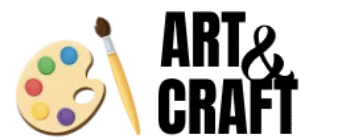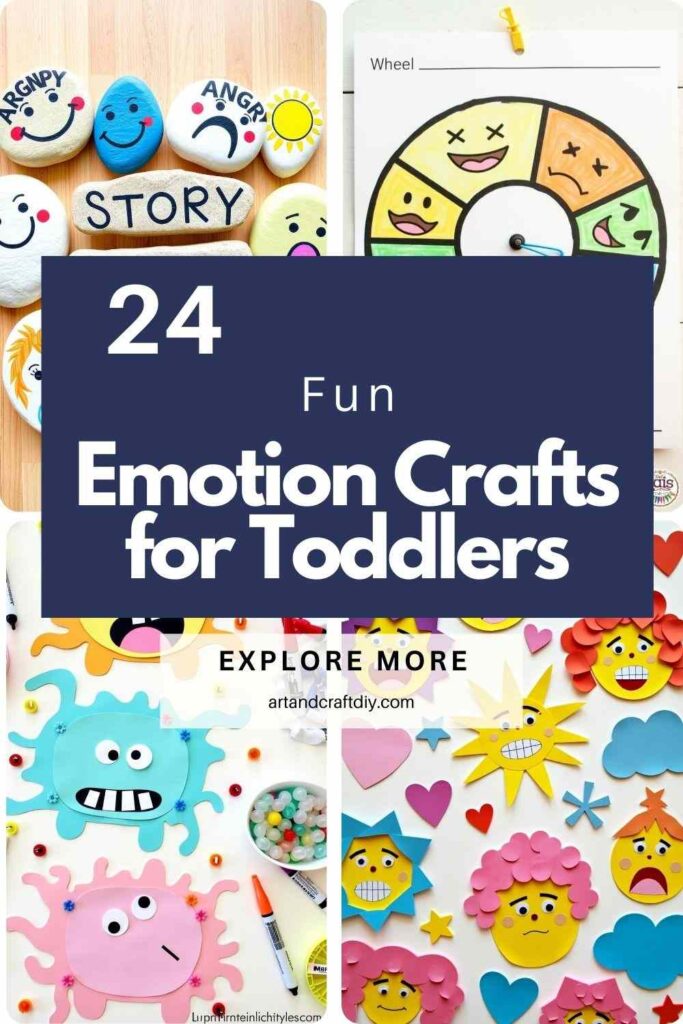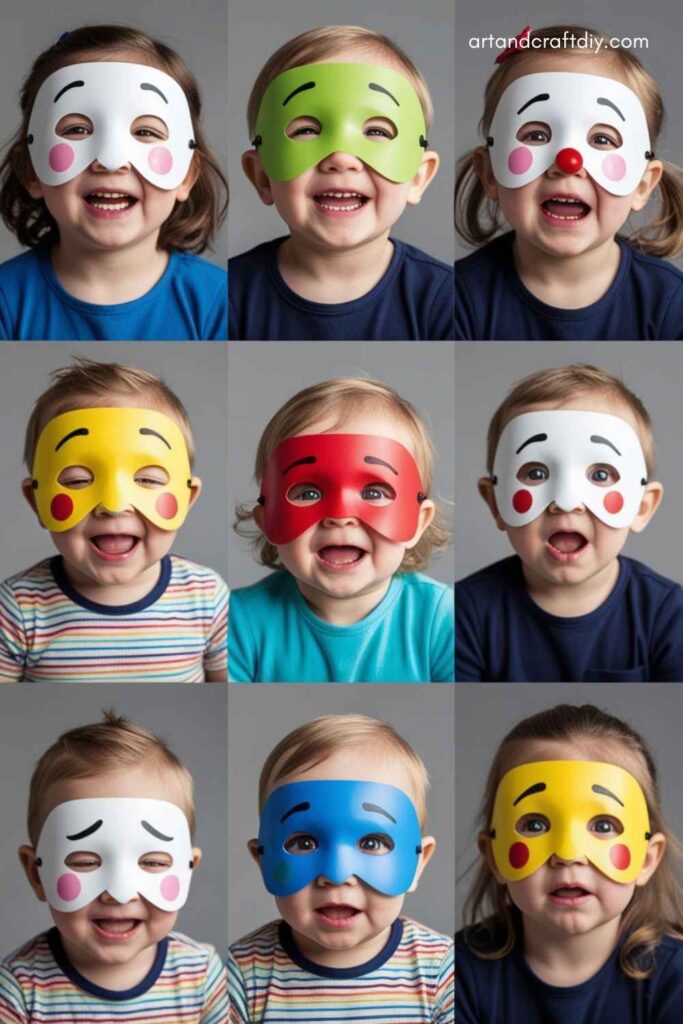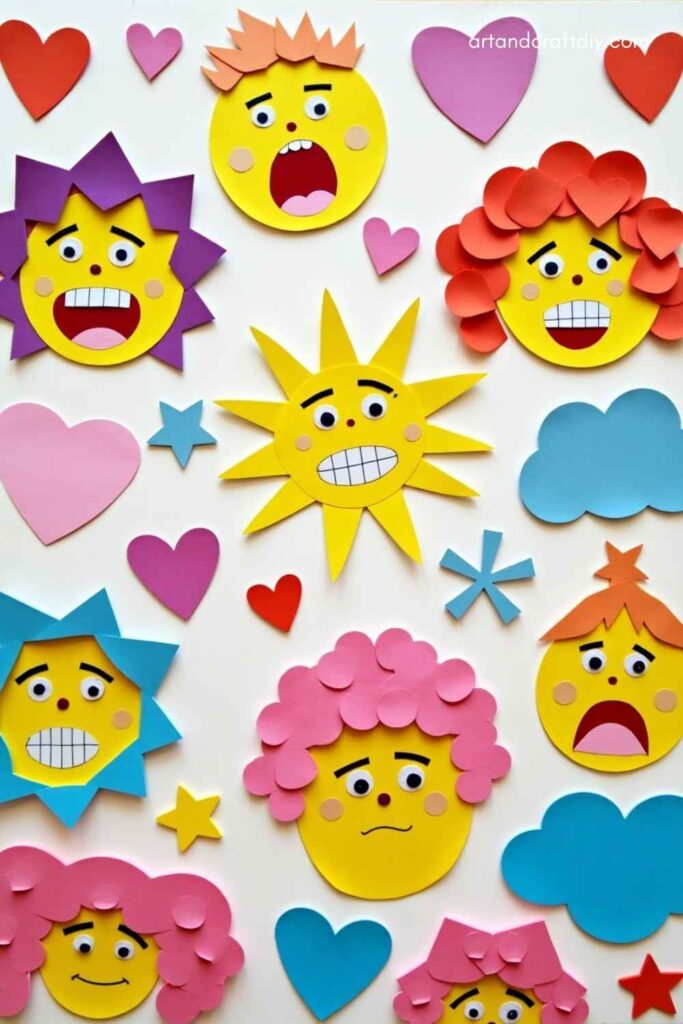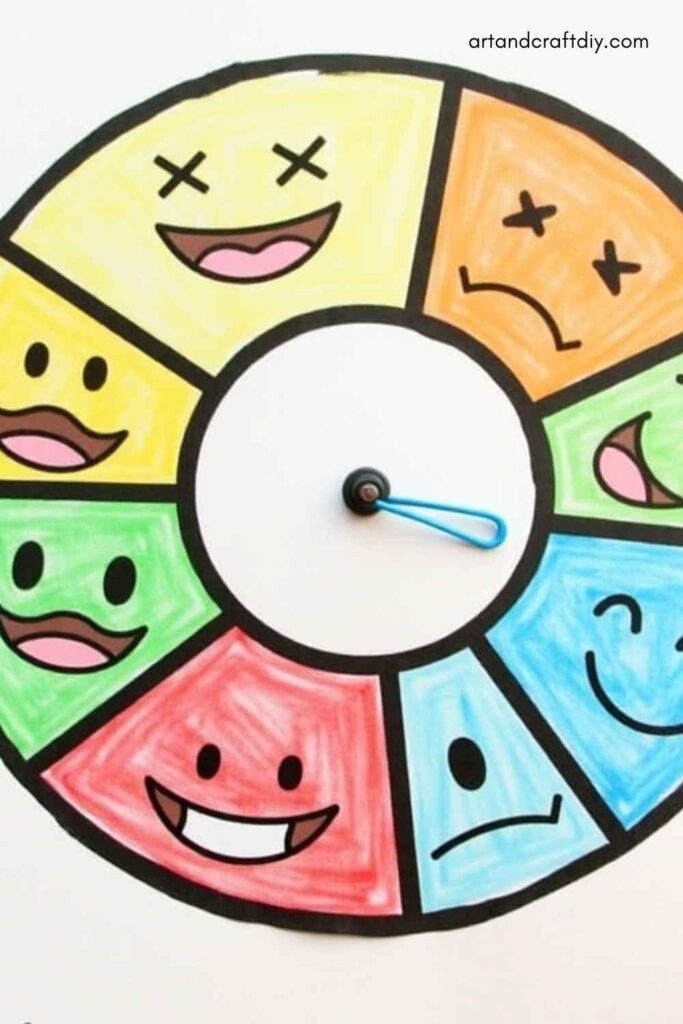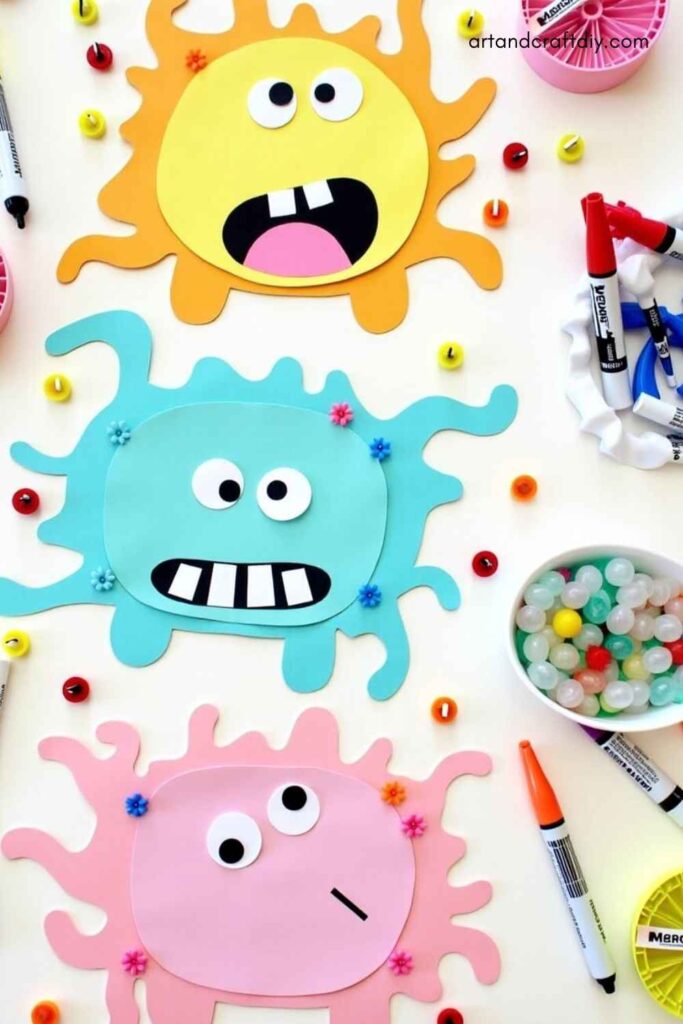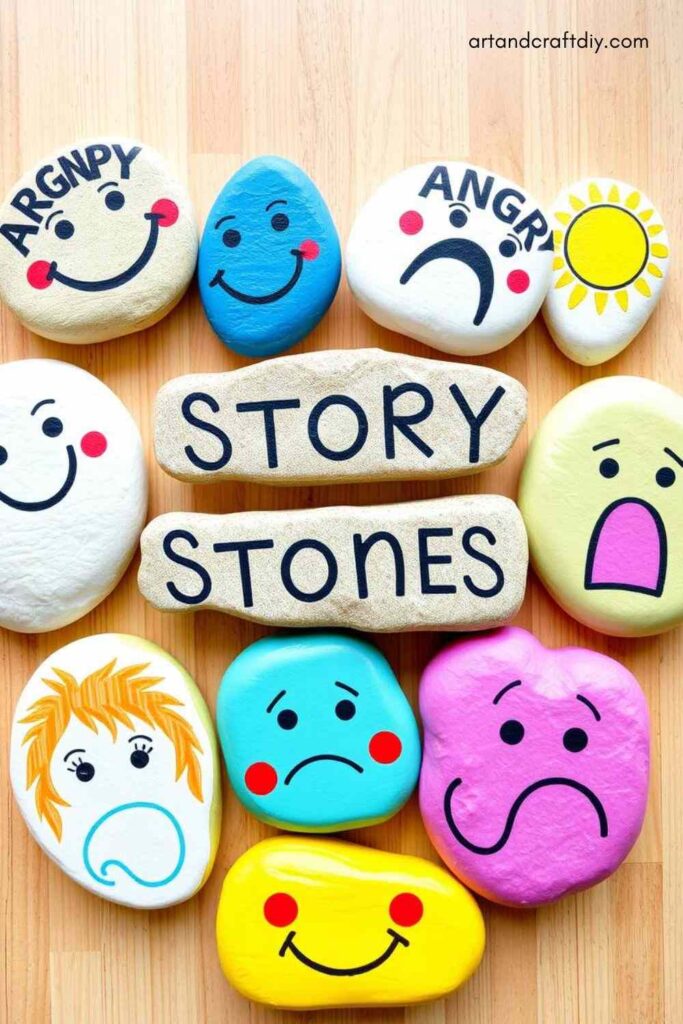Emotion Crafts for Toddlers are a fun and easy way to help young children learn about their feelings. Toddlers are just starting to understand and show emotions, so this is a great time to use simple crafts to teach them. These hands-on activities are not only fun to make but also help little ones learn about feelings like happy, sad, angry, and surprised in a gentle and playful way.
Emotion Crafts for Toddlers
Emotion Crafts for Toddlers are fun, hands-on activities that help young children explore and understand their feelings. These simple crafts make learning about emotions playful and easy.
Emotion Mask Craft
Introduce toddlers to different emotions by creating fun masks that reflect feelings like happiness, sadness, and surprise. This craft allows toddlers to explore facial expressions and emotions in a hands-on way.
How to Make:
-
Materials: Paper plates, craft sticks, markers, glue
-
Instructions: Draw various facial expressions (happy, sad, angry, surprised) on paper plates. Attach a craft stick to the bottom for holding. Encourage toddlers to wear the masks and act out different emotions.
Feelings Faces Collage
This activity lets toddlers recognize facial expressions while creating a colorful collage. It’s a great way to visually associate emotions with faces.
How to Make:
-
Materials: Old magazines, scissors, glue, paper
-
Instructions: Cut out pictures of faces showing different emotions from magazines. Glue them onto a large sheet of paper and talk about the emotions each face represents.
Emotion Wheel
An interactive craft where toddlers can spin the wheel to express how they feel that day, promoting self-awareness and emotional vocabulary.
How to Make:
-
Materials: Cardstock, split pin, markers
-
Instructions: Draw a circle and divide it into sections, labeling each with an emotion (happy, sad, angry, etc.). Attach a split pin to the center and create an arrow that can spin to point to different emotions.
Mood Monsters
Toddlers create their own little monsters that represent various emotions, offering a fun way to talk about feelings and how they change.
How to Make:
-
Materials: Colored paper, googly eyes, pipe cleaners, glue
-
Instructions: Cut out monster shapes from colored paper. Add googly eyes and pipe cleaner arms or legs. Let toddlers decorate the monsters based on different emotions, naming each one.
Story Stones
These painted stones allow toddlers to tell stories about emotions, creating an engaging and imaginative way to discuss feelings.
How to Make:
-
Materials: Smooth stones, paint, clear sealant
-
Instructions: Paint simple faces on the stones, each representing a different emotion. Use the stones as prompts for storytelling, where toddlers can choose a stone and create a tale about the emotion it represents.
Emotion Puppets
Using paper bags or socks, toddlers can make puppets that show various emotional expressions, perfect for acting out different feelings.
How to Make:
-
Materials: Paper bags or socks, yarn, markers, glue
-
Instructions: Create puppets by adding yarn for hair and markers for faces. Let toddlers use the puppets to role-play emotions and discuss feelings in a fun way.
Feelings Flashcards
This simple craft helps toddlers recognize and label different emotions by creating flashcards that they can reference when talking about their feelings.
How to Make:
-
Materials: Cardstock, markers, real photos or drawings
-
Instructions: Draw faces showing different emotions or paste photos of people showing those emotions. Use the flashcards to discuss what makes you feel happy, sad, or excited.
“How Do You Feel?” Mirror Craft
Toddlers can look in their own mirror and mimic facial expressions, helping them connect with their emotions.
How to Make:
-
Materials: Paper plate, foil, markers
-
Instructions: Create a reflective surface by using foil as the mirror. Draw a simple face on the plate and decorate it. Let toddlers use the mirror to make facial expressions and talk about how they feel.
Feelings Journal
Encourage toddlers to create their own feelings journal to draw or paste pictures of what makes them happy, sad, or mad.
How to Make:
-
Materials: Small notebook, crayons, stickers
-
Instructions: Let toddlers decorate their journals and encourage them to draw pictures or add stickers that represent different emotions. Use the journal as a tool to discuss daily feelings.
Emotional Tree
This activity helps toddlers visualize their emotions by creating a tree with leaves that represent different feelings.
How to Make:
-
Materials: Construction paper, scissors, glue
-
Instructions: Cut out a tree trunk and branches. Create different colored leaves, each representing an emotion. Let toddlers glue the leaves to the tree, talking about how each color or shape represents a feeling.
Emotion Bottle
Create a sensory bottle that toddlers can shake to help calm their emotions. It’s a great tool for teaching self-regulation.
How to Make:
-
Materials: Clear plastic bottle, glitter, water, food coloring
-
Instructions: Fill the bottle with water, add glitter and a few drops of food coloring. Seal the bottle tightly. Encourage toddlers to shake the bottle and watch the glitter settle, discussing how it feels when emotions calm down.
Happy/Sad Rock Painting
Toddlers can express their emotions by painting rocks with happy or sad faces, offering a creative way to explore feelings.
How to Make:
-
Materials: Smooth rocks, paint, brushes
-
Instructions: Paint simple happy and sad faces on rocks. Let toddlers paint their own faces to match how they are feeling, and discuss what each face represents.
Emotion Color Sorting
This craft helps toddlers associate colors with different emotions, making it a fun and educational way to learn about feelings.
How to Make:
-
Materials: Colored paper or fabric squares, baskets
-
Instructions: Assign a color to each emotion (e.g., red for anger, blue for sadness, yellow for happiness). Toddlers sort the colored squares into baskets based on the emotion they represent.
Feelings Bracelet
A sensory craft where toddlers can create a bracelet that symbolizes different emotions using colorful beads.
How to Make:
-
Materials: Beads, string
-
Instructions: Use different colored beads to represent different emotions. Toddlers can string them together to create a bracelet that represents how they are feeling that day.
Feelings Sorting Activity
Help toddlers learn to categorize different emotions through a fun sorting game that uses faces or objects representing emotions.
How to Make:
-
Materials: Printable cards or cut-outs of faces, baskets or containers
-
Instructions: Create cards with different faces showing emotions like happy, sad, angry, etc. Let toddlers sort the cards into different containers based on the emotions they see.
Tips for Parents and Educators
When introducing emotion crafts to toddlers, it’s important to create a supportive and enjoyable environment that encourages self-expression. These activities are meant to help children explore their feelings, and your involvement can make a huge difference in how they connect with the craft and its lessons. Here are some tips to guide you through the process:
-
Keep it simple and age-appropriate: Use basic materials and instructions that are easy for toddlers to follow. Avoid overwhelming them with complex tasks, and focus on simple emotions like happy, sad, or angry.
-
Allow freedom in expression—there’s no “wrong” face: Let toddlers create whatever facial expressions they feel. Emphasize that emotions are personal, and there is no right or wrong way to express them. This builds confidence and encourages emotional honesty.
-
Use books or songs to support the craft: Pair your craft activities with stories or songs that highlight different emotions. Books like The Color Monster or songs like “If You’re Happy and You Know It” can help reinforce the emotional lessons during the craft time.
-
Reinforce learning by asking reflective questions: After completing an activity, ask toddlers questions like, “When did you feel like this?” or “What makes you feel happy/sad?” These questions prompt children to reflect on their emotions and help solidify their understanding of feelings.
By following these tips, you’ll create a fun, engaging, and educational atmosphere where toddlers can confidently explore and express their emotions.
FAQ
What age group is best for emotion crafts?
Emotion crafts are ideal for toddlers, typically ages 2 to 5. At this age, children are beginning to understand and express their emotions, making it a great time to introduce crafts that help them explore feelings in a fun and interactive way.
Why are emotion crafts important for toddlers?
Emotion crafts help toddlers recognize and label their feelings, which is an important part of emotional development. These activities promote empathy, self-expression, and communication skills, allowing children to better understand their own emotions and those of others.
How can I make emotion crafts fun for toddlers?
Keep the activities playful and interactive. Use bright colors, fun materials, and encourage creative freedom. Let toddlers choose how to express themselves, and avoid focusing on perfection—this is about exploring emotions, not creating flawless art.
Are emotion crafts suitable for group activities?
Yes! Emotion crafts can be a great group activity for toddlers. They encourage sharing, cooperation, and discussing different feelings. Group activities allow children to learn from each other and practice social-emotional skills in a supportive environment.

Hi, I’m Victoria, an art and craft teacher at Newark City Schools, where I have the joy of working with middle school students to help them explore their creativity and develop their artistic talents. I believe that art is a powerful way for students to express themselves, and I strive to make every lesson a fun, engaging, and inspiring experience.
I created this website to share the art and craft projects, techniques, and resources that I use in my classroom, hoping to inspire both educators and young artists alike. Whether you’re a teacher looking for new ideas or a student eager to try something new, I’m excited to provide creative tools and projects that anyone can enjoy.
When I’m not in the classroom, I love experimenting with different art forms and learning new crafting techniques. My goal is to help others discover the joy of making things with their hands, and I hope my website serves as a space for everyone to explore their creative potential.
